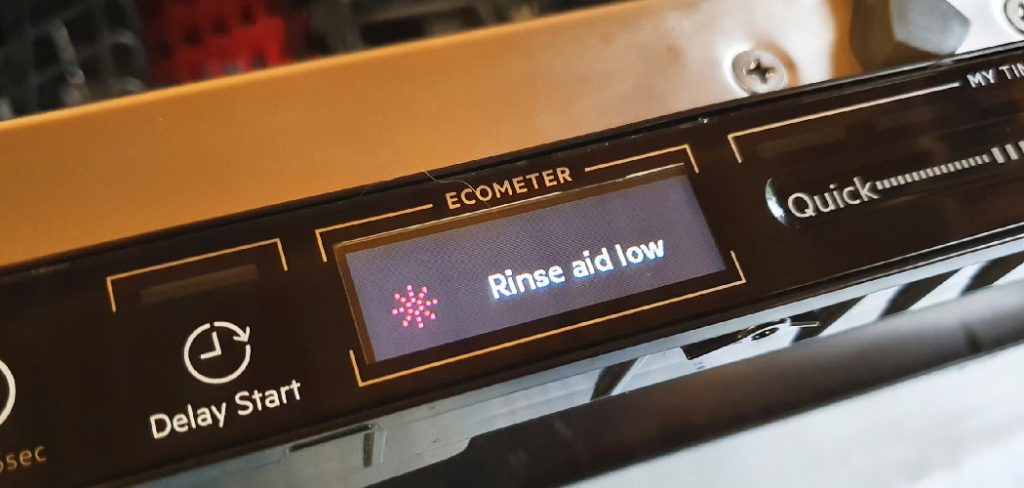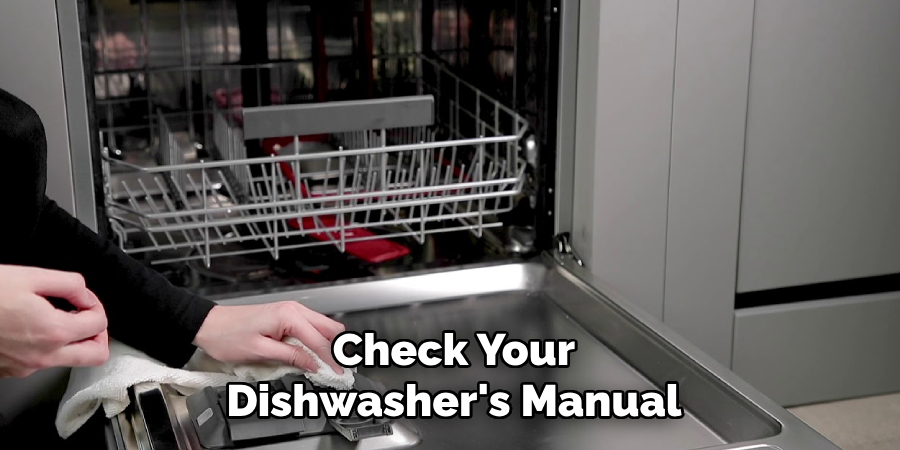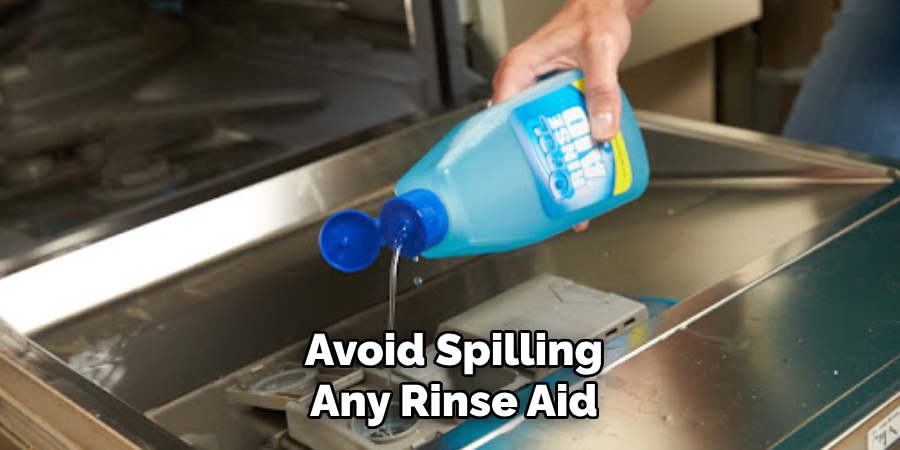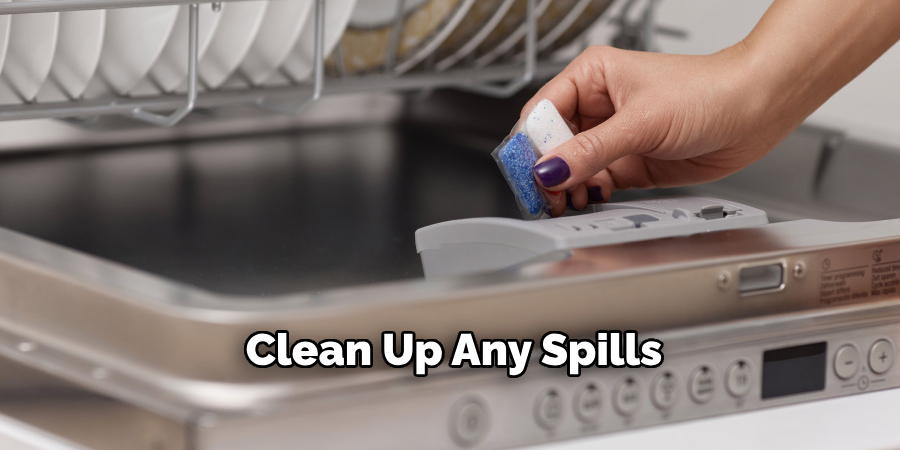Adding rinse aid to your dishwasher is a simple yet essential step to ensure your dishes come out spotless and streak-free. Rinse aid helps water slide off dishes more easily, preventing water spots and improving the drying process.

Whether you’re new to using a dishwasher or looking to optimize its performance, this guide on how to put rinse aid in a dishwasher will walk you through the process of properly filling the rinse aid dispenser.
Why Use Rinse Aid?
Rinse aid is a liquid solution that is specifically formulated to be used with dishwashers. It helps to eliminate water spots and improve the drying process by reducing surface tension. Without rinse aid, water tends to cling to dishes and causes those pesky spots that can be hard to remove.
Not only does using rinse aid result in sparkling dishes, but it also helps to prolong the life of your dishwasher. When water spots are left on dishes, they can build up on the interior of your dishwasher, leading to clogs and potential damage over time.
Things to Consider Before Adding Rinse Aid to Your Dishwasher
- Make sure your dishwasher has a built-in rinse aid dispenser.
- Check the manufacturer’s instructions for recommended rinse aid products.
- Consider using a rinse aid with natural ingredients for an eco-friendly option.
- Avoid overfilling the dispenser, as this can lead to excess suds and poor cleaning results.
- If you have hard water, choose a rinse aid with built-in water softeners.
8 Steps on How to Put Rinse Aid in a Dishwasher
Step 1: Locate the Rinse Aid Dispenser
Open your dishwasher door fully to access the interior of the machine. The rinse aid dispenser is typically located on the inside of the dishwasher door, near the detergent compartment.

It is usually marked with a symbol or label, such as “Rinse Aid” or a water droplet icon, making it easy to identify. Check your dishwasher’s manual for the exact location if you’re unsure.
Step 2: Check the Level of Rinse Aid
Before adding any rinse aid, check the current level in the dispenser. Most rinse aid dispensers have a transparent or semi-transparent window that allows you to see how much is left. If the dispenser appears empty or the level is low, it’s time to refill it.
Some dishwashers may also have an indicator light on the control panel that alerts you when the rinse aid needs to be replenished. Ensure the dispenser is not overflowing, as this can affect the dishwasher’s performance.
Step 3: Choose the Right Rinse Aid
As mentioned earlier, it’s important to use a rinse aid that is recommended for your particular dishwasher model. Refer to the manufacturer’s instructions or do some research online before purchasing a rinse aid product.
You can also consider factors like eco-friendliness, scent, and compatibility with hard water when choosing a rinse aid.
Step 4: Unscrew the Rinse Aid Cap
Once you have identified and checked the rinse aid dispenser, carefully unscrew or lift the cap to open it. Most dispensers are designed with a simple twist mechanism, but some may have a flip-top cap instead.
Turn the cap counterclockwise to loosen it, or gently lift it, depending on your dishwasher model. Be sure to place the cap in a safe spot to avoid misplacing it during the process. Take care not to force the cap if it feels stuck, as this could lead to damage. If you encounter difficulty, consult your dishwasher’s manual for guidance.
Step 5: Pour in the Rinse Aid
With the cap removed, it’s time to add the rinse aid. Hold the bottle or dispenser of rinse aid over the open compartment and pour it slowly until it reaches the recommended fill line. Avoid spilling any rinse aid on other parts of the dishwasher, as this can cause damage or create excess suds during a cycle.

You can also use a funnel to pour the rinse aid more precisely. If you spill anything on the dishwasher, wipe it clean with a damp cloth before closing the dispenser.
Step 6: Replace the Cap
Once the rinse aid compartment is filled to the recommended level, take the cap and carefully reattach it to the dispenser. Align the cap properly and turn it clockwise to tighten it securely. If your dispenser has a flip-top cap, ensure it snaps back into place firmly.
Double-check that the cap is sealed correctly to prevent any leakage during the washing cycle. This step is crucial for keeping the rinse aid contained and ensuring optimal dishwasher performance.
Step 7: Wipe Away Any Spills
If you did spill any rinse aid during the filling process, use a damp cloth to wipe it away. Rinse aid can leave residue on surfaces, so it’s important to clean up any spills promptly. This will also prevent the possibility of excess suds or damage to your dishwasher.
It’s also a good idea to check for any spills or residue on the bottom of your dishwasher before closing the door. This will ensure that no rinse aid has dripped onto your dishes, which can affect their cleaning and drying results.

Step 8: Start Your Dishwasher
Now that the rinse aid is properly filled, you can close the dishwasher door and start a cycle. The rinse aid will be dispensed during the final rinse to help dry and protect your dishes.
Remember to regularly check the level of rinse aid in your dispenser and refill it when needed. How often this needs to be done will depend on how frequently you run your dishwasher.
Following these steps on how to put rinse aid in a dishwasher will help you properly add rinse aid to your dishwasher and achieve sparkling, spot-free dishes with every wash. Happy dishwashing! So why not take the extra step and add some rinse aid to your dishwasher routine for even better results? Your dishes and dishwasher will thank you.
Additional Tips
- If you have hard water, consider adding a dishwasher cleaner or descaler to your routine. This will help reduce buildup and maintain optimal performance.
- Avoid using vinegar as a replacement for rinse aid, as it can cause damage to your dishwasher over time.
- If you notice that your dishes are still not coming out clean after adding rinse aid, check the level in the dispenser and refill if necessary. It’s also a good idea to clean any filters or spray arms that may be clogged with food debris.
- Regularly wiping down the interior of your dishwasher and removing any buildup or residue can also help improve its performance and prolong its lifespan.
- If you’re unsure about which rinse aid product to use or how much to add, consult your dishwasher’s manual or contact the manufacturer for guidance.
- Lastly, don’t forget to also regularly clean and maintain your dishwasher by running hot water through it and wiping down the exterior. This will help keep it in top condition for efficient and effective washing. Overall, proper use of rinse aid and regular maintenance of your dishwasher can greatly improve its performance and ensure sparkling clean dishes every time. So be sure to follow these steps and additional tips for optimal results!
Frequently Asked Questions
Q: Can I Use Vinegar as a Rinse Aid in My Dishwasher?
A: Yes, you can use white vinegar as an alternative to traditional rinse aids. However, it may not be as effective at preventing water spots and etching on dishes.
Q: How Often Should I Refill My Rinse Aid Dispenser?
A: This will depend on how often you run your dishwasher and the capacity of your dispenser. It’s recommended to check the level before every wash and refill as needed.
Q: Can I Use Dish Soap in Place of Rinse Aid?
A: No, dish soap is not a suitable substitute for rinse aid. It can create excess suds which can damage your dishwasher or leave residue on dishes.
Q: Can I Use Homemade Rinse Aid in My Dishwasher?
A: While some DIY rinse aid recipes can be effective, it’s best to use a commercial product recommended for your dishwasher model. These are designed and tested specifically for dishwashers, ensuring optimal results. So if you’re opting for homemade rinse aid, do some research and testing before using it in your dishwasher.

Q: Why Do I Need to Use Rinse Aid in My Dishwasher?
A: Rinse aid helps with the drying process by preventing water spots and promoting faster evaporation on dishes. It also helps to protect your dishwasher from limescale buildup and can improve the overall cleanliness of your dishes.
Conclusion
Adding rinse aid to your dishwasher is a simple but effective way to improve the cleanliness and longevity of your machine. By following these steps on how to put rinse aid in a dishwasher and keeping a few important factors in mind, you can ensure that your dishes come out sparkling clean every time.
Consider using rinse aid as part of your regular dishwasher maintenance routine for optimal results. So go ahead and try it out – your dishes will thank you! Happy dishwashing!
Professional Focus
Angela Ervin, a former interior designer turned blogger, specializes in kitchen design and renovations. Through her website, she blends her passion for cooking with design expertise, sharing practical and creative ideas. Known for balancing functionality and beauty, Angela’s insightful content has made her a trusted voice in home design and lifestyle.
About the Author
Angela Ervin, an experienced interior designer and blogger, combines her passion for kitchen renovations with storytelling. Living in Petersburg with her family, she enjoys cooking and testing her projects firsthand. Known for her humor and relatable style, Angela shares creative, functional design insights through her content, making her a trusted voice in home design.
Education History
University: Virginia Commonwealth University
Degree: Bachelor of Fine Arts (BFA) in Interior Design
- Angela’s education at VCU focused on mastering core interior design principles, including spatial planning, color theory, materials selection, and sustainable design practices.
- She gained hands-on experience through studio projects and collaborative design exercises, which honed her ability to create functional and aesthetically pleasing environments.
- Her coursework also emphasized problem-solving and practical applications of design, preparing her for real-world projects like her self-directed kitchen renovations.
- The program’s strong foundation in both technical skills and creative expression shaped Angela’s ability to seamlessly integrate form and function in her work.
